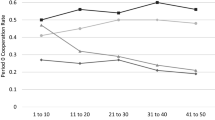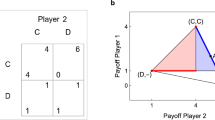Abstract
We study the development of cooperation in a repeated prisoner’s dilemma experiment with teams as players, unknown length and unknown continuation probability as it could happen between traders regularly. To characterize real-world frictions our players are rematched with a new team twice. In such a situation—often found outside the laboratory—agents can get an idea on the likely duration of future interactions by relying on prior experience. Our main finding is that participants apparently transform the infinite-horizon situation into a finite-horizon situation. Not only do we observe decay in cooperation but also unraveling towards the end of a matching. We found a pronounced restart effect of cooperation that induces a steady rise in average cooperation over matchings. Such an effect is not observed after the unexpected continuation of the third match. Stable cooperation paths of considerable length are induced when both players start the matching with joint cooperative moves. We can draw some interesting conclusions from the behavior of the partners for commercial market situations.




Similar content being viewed by others
References
Andreoni J, Miller JH (1993) Rational cooperation in the finitely repeated prisoner’s dilemma: experimental evidence. Econ J 103:570–585
Axelrod R (1984) The evolution of cooperation. Basic Books, New York
Axelrod R (2000) On six advances in cooperation theory. Anal Krit 22:130–151
Beckenkamp M, Hennig-Schmidt H, Maier-Rigaud F (2010) Cooperation in symmetric and asymmetric prisoner’s dilemma games. Max Planck Institute for Research on Collective Goods Bonn. Preprint No. 2006/25; revised version 2010
Beckenkamp M, Engel Ch, Glöckner A, Hennig-Schmidt H, Irlenbusch B, Kube S, Kurschilgen M, Morell A, Nicklisch A, Normann HT, Towfigh E (2014) First impressions are more important than early intervention—qualifying broken windows theory in the lab. Int Rev Law Econ 37:126–136
Dal Bó P (2005) Cooperation under the shadow of the future. Experimental evidence from infinitely repeated games. Am Econ Rev 95:1591–1604
Dal Bó P, Fréchette GR (2011) The evolution of cooperation in infinitely repeated games: experimental evidence. Am Econ Rev 101:411–429
Duffy J, Ochs J (2009) Cooperative behavior and the frequency of social interaction. Games Econ Behav 66:785–812
Fandel G, Giese A, Mohn B (2012) Measuring synergy effects of a Public Social Private Partnership (PSPP) project. Int J Prod Econ 140:815–824
Fischbacher U, Gächter S, Fehr E (2001) Are people conditionally cooperative? Evidence from a public goods experiment. Econ Lett 71:397–404
Holt Ch (1995) Industrial organization. In: Kagel JH, Roth AE (eds) The handbook of experimental economics. Princeton University Press, Princeton, pp 347–443
Murnighan JK, Roth AE (1983) Expecting continued play in prisoner’s dilemma games. J Confl Resolut 27:279–300
Normann HT, Wallace B (2012) The impact of the termination rule on cooperation in a prisoner’s dilemma experiment. Int J Game Theory 41:707–718
Rapoport A, Chammah AM (1965) Prisoner’s dilemma. University of Michigan Press, Ann Arbor
Rapoport A, Dale PS (1966) The “end” and “start” effects in iterated prisoner’s dilemma. J Confl Resolut 10:363–366
Roth AE, Murnighan JK (1978) Equilibrium behavior and repeated play of the prisoner’s dilemma. J Math Psychol 17:189–198
Selten R, Stöcker R (1986) End behavior in sequences of finite prisoner’s dilemma supergames. A learning theory approach. J Econ Behav Organ 7:47–70
Acknowledgments
Our particular thanks go to Thomas Brenner who was involved in early stages of this research. Furthermore, Ulrike Leopold-Wildburger is grateful for financial support by the Austrian National Bank (OENB Grant 13 173).
Author information
Authors and Affiliations
Corresponding author
Appendices
Appendix 1: Instructions
1.1 Introduction
You are participating in an experiment where you will decide in a team jointly with other participants. The decision process within the team will be video taped.
In total, four teams are participating in this experiment. Each team anonymously interacts with one of the other three teams at a time, but during the experiment, each team will be playing against each of the other three teams.
Your own team’s payoff depends on your own and the other team’s decision. Decisions within a round are taken simultaneously. Only after you have taken your decision, you will be informed on the choice of the team you are interacting with and thus on your payoff in the previous round.
Each team is provided with a protocol indicating all decisions and the resulting payoffs in points. Each team can choose between decision A or B. The following table shows the payoffs resulting from all combinations of your own decision and the choice of the other team.
Own team’s decision | Other team’s decision | Number of points own team | Number of points other team |
|---|---|---|---|
A | A | a | a |
A | B | b | c |
B | A | c | b |
B | B | d | d |
Payoffs a, b, c and d are substituted by numbers in the protocol. All teams are given an identical protocol and the numbers a, b, c, d are the same for all teams.
Each decision has to be discussed within the team. After having taken your decision, please enter the corresponding letter into the table named “History of interaction”.
Your decision has to be taken unanimously or according to a decision rule unanimously agreed upon. Each team member has to agree on this decision by signing the decision protocol in the column “signatures”.
After having decided, the choice of your team will be transmitted to the other team. Please enter the other team’s decision and the number of points each team gained into the table as well.
Each team will be playing for several consecutive rounds with the same team. After some time not known to the participants in advance, the team you are playing against will be changed. This happens twice; you, therefore, interact three times with a different team. The time of change will not be announced in advance. We will, however, inform you as soon as teams have changed. In total, the interaction with all three teams will not take more than 90 min.
At the end of the experiment, please sum up your own team’s number of points. The point to cash rate is 0.36€. Each team member will be paid the amount in € resulting from the total number of points entered into the decision protocol. In addition, each participant receives a show-up fee of 2.5€.
Following this introduction you will be randomly matched into teams by drawing a card marked with a letter. Participants having drawn the same letter play together in one team. Groups will be led into rooms separated from each other.
Do you have any questions?
1.2 Decision protocol
Payoff table for any possible interaction outcome:
Own team’s decision | Other team’s decision | Number of points own team | Number of points other team |
|---|---|---|---|
A | A | 3 | 3 |
A | B | 0 | 5 |
B | A | 5 | 0 |
B | B | 1 | 1 |
History of interaction:
Round | Own team’s decision | Signature | Other team’s decision | Number of points own team | Number of points other team |
|---|---|---|---|---|---|
1. | |||||
2. | |||||
3. | |||||
4. | |||||
5. | |||||
6. | |||||
7. | |||||
… | |||||
29. | |||||
Total number of points | |||||
Appendix 2: Path dependence in each matching: frequency of joint decisions in Round 4 given joint initial moves in Round 1
Appendix 3
See Fig. 2.
Rights and permissions
About this article
Cite this article
Hennig-Schmidt, H., Leopold-Wildburger, U. The shadow of the past: how experience affects behavior in an iterated prisoner’s dilemma experiment. J Bus Econ 84, 865–878 (2014). https://doi.org/10.1007/s11573-014-0707-7
Published:
Issue Date:
DOI: https://doi.org/10.1007/s11573-014-0707-7
Keywords
- Repeated prisoner’s dilemma
- Unknown length
- Unknown continuation probability
- Experience
- Conflict of cooperation
- Restart effect




